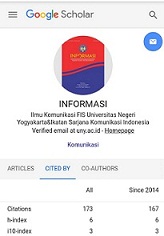INTERAKSIONISME SIMBOLIK SANTRI TERHADAP KIAI MELALUI KOMUNIKASI DI PONDOK PESANTREN AL MUNAWWIR KLRAPYAK YOGYAKARTA
DOI:
https://doi.org/10.21831/informasi.v46i2.11800Keywords:
Symbolic Interactionism, Communication, Islamic Boarding School.Abstract
This research aims to determine the perspective of symbolic interactionism students to kiai in the communication process in Al Munawwir Islamic Boarding School Krapyak Yogyakarta. To achieve the objectives of the study, researchers used a qualitative approach, with qualitative descriptive type. The subjects in this study were students at Al Munawwir Boarding School Krapyak Yogyakarta. Data retrieval is done through interviews and observation. Results found is that symbolic interactionism students are not deterministic. That is, what is done by the students of the kiai is a subjective awareness of students who interpret certain symbols through interaction. The fact then that creates a social world for students. Social world that includes an appearance, gestures and symbolic language emerged in social situations, so in this context, the social world at the boarding school students can be said is a product of individuals as actors who are activeReferences
Ardianto, Elvinaro. 2010. Metode Penelitian untuk Public Relations: kuantitatifdan Kualitatif. Bandung: Simbiosa Rekatama Media
Danesi, Marcel. 2011. Pesan, Tanda, dan Makna: Buku Teks Dasar Mengenai Semiotika dan Teori Komunikasi. Yogyakarta: Jalasutra
Dhofier, Zamakhsyari. 1982. Tradisi Pesantren: Studi tentang Pandangan Hidup Kiai. Jakarta: LP3ES.
Haryanto, Sugeng. 2012. Persepsi Santri Terhadap Perilaku Kepemimpinan Kiaidi Pondok Pesantren: Studi Interaksionisme Simbolik di Pondok Pesantren Sidogiri Pasuruan. Kementerian Agama RI
Idrus, Muhammad. 2009. Metode Penelitian Ilmu Sosial. Yogyakarta: Erlangga
Littlejohn, Stephen W. & Keren A. Foss. 2009. Teori Komunikasi. Jakarta: Salemba
Majid, Nurcholis. 1997. Bilik-Bilik Pesantren: Sebuah Potret Perjalanan. Jakarta:Paramadina
Mufid, Muhammad. 2010. Etika dan Filsafat Komunikasi. Jakarta: KencanaPernada Media Group
Mulyana, Deddy. 2008. Komunikasi Efektif: Suatu Pendekatan Lintasbudaya.Bandung: PT Remaja Rosdakarya
Mutalimah. 2003. Model Pembaharuan Sistem Pendidikan Pesantren Salaf di PP. Al Munawwir Krapyak Yogyakarta. Skripsi. Fakultas Tarbiyah InstitutAgama Islam Negeri Sunan Kalijaga Yogyakarta.
Kriyantono, Rachmat. 2010. Teknik Praktis Riset Komunikasi: Disertai Contoh Praktis Riset Media, Public Relations, Advertising, KomunikasiOrganisasi, Komunikasi Pemasaran. Jakarta: Kencana
Prawito, 2007.Penelitian Komunikasi Kualitatif. Yogyakarta: LKiS
Riyanto, Waryani Fajar & Mokhamad Mahfud. 2012. Komunikasi Islam (I).Yogyakarta: Galuh Patria
Rochman, Agus Ghozali. 2008. Peran Kepemimpinan Kiai dalam MeningkatkanMutu Pendidikan Pesantre: Studi Kasus Pondok Pesantren KomplekNurussalam Al Munawwir Krapyak Yoyakarta.Skripsi. Fakultas Tarbiyah UIN Sunan Kalijaga Yogyakarta
Ruben, D. Brent dan Lea P. Stewart. 2013. Komunikasi dan Perilaku Manusia. Jakarta rajawali Press
Sugiyono, 2008.Memahami Penelitian Kualitatif. Bandung: Afabeta
Suranto AW. 2011. Komunikasi Interpersonal. Yogyakarta: Graha Ilmu
Umiarso dan Elbandiasyah. 2014. Interaksionisme Simbolik Dari Era Klasik Hingga Modern. Jakarta: PT Raja Grafindo Persada
Tarmizi. 2010. Pola Interaksi Antar Umat Beragama dalam TeoriInteraksionisme Simbolik Masyarakat Agama (Studi Kasus di Sorowajan).Skripsi. Fakultas Ushuluddin UIN Sunan Kalijaga Yogyakarta
Widodo, Suko. 2010. Anatomi dan Perkembangan Sosial. Malang: Aditya MediaPublishing
W. Syam, Nina. 2009. SosiologiKomunikasi. Bandung: Humaniora
Darno. 2010. Rambut Gondrong dalam Konteks Kode Etik Mahasiswa UIN SunanKalijaga Yogyakarta (Menurut Perspekstif Interaksionisme Simbolik). Skripsi. Fakultas Ilmu Sosial dan Humaniora UIN Sunan KalijagaYogyakarta
Downloads
Published
Issue
Section
License
Authors who publish with this journal agree to the following terms:- Authors retain copyright and grant the journal right of first publication with the work simultaneously licensed under a Creative Commons Attribution License that allows others to share the work with an acknowledgement of the work's authorship and initial publication in this journal.
- Authors are able to enter into separate, additional contractual arrangements for the non-exclusive distribution of the journal's published version of the work (e.g., post it to an institutional repository or publish it in a book), with an acknowledgement of its initial publication in this journal.
- Authors are permitted and encouraged to post their work online (e.g., in institutional repositories or on their website) prior to and during the submission process, as it can lead to productive exchanges, as well as earlier and greater citation of published work (See The Effect of Open Access).





















